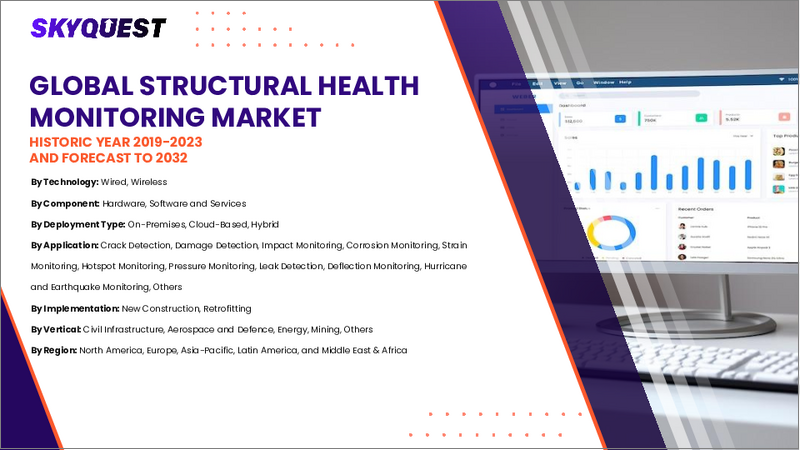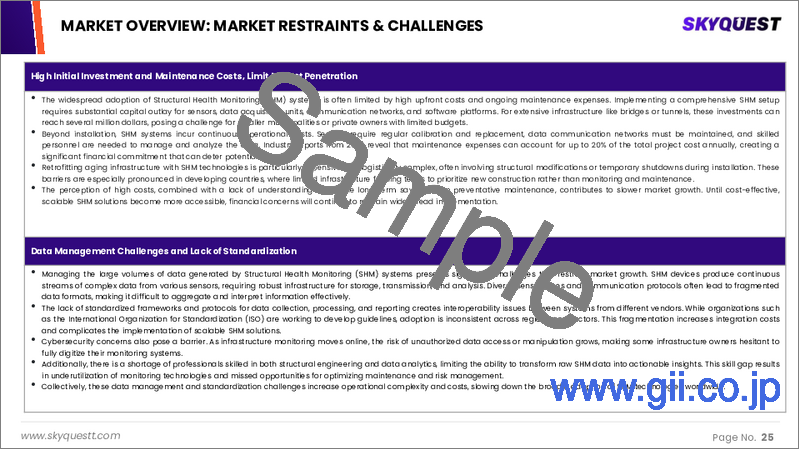|
|
市場調査レポート
商品コード
1701745
構造ヘルスモニタリングの市場の市場規模、シェア、成長分析、コンポーネント別、技術別、業界別、用途別、実装別、地域別 - 産業予測 2025~2032年Structural Health Monitoring Market Size, Share, and Growth Analysis, By Components (Hardware, Software and Services), By Technology (Wired, Wireless), By Vertical, By Applications, By Implementation, By Region - Industry Forecast 2025-2032 |
||||||
|
|||||||
| 構造ヘルスモニタリングの市場の市場規模、シェア、成長分析、コンポーネント別、技術別、業界別、用途別、実装別、地域別 - 産業予測 2025~2032年 |
|
出版日: 2025年04月06日
発行: SkyQuest
ページ情報: 英文 157 Pages
納期: 3~5営業日
|
全表示
- 概要
- 目次
構造ヘルスモニタリング市場規模は2023年に31億米ドルと評価され、2024年の34億4,000万米ドルから2032年には79億3,000万米ドルに成長し、予測期間(2025-2032年)のCAGRは11.0%で成長する見通しです。
構造ヘルスモニタリング(SHM)市場は、土木技術者が先進的なシステムを活用して安全性を高め、橋、ダム、スタジアムなどの重要なインフラのメンテナンスコストを削減することで、大きな成長が見込まれています。SHM技術は、データ収集、センサー、分析装置を統合することで、特に発展途上地域のスマートシティのような大規模プロジェクトにおいて、損傷を効果的に検出し、資源配分を最適化する予知保全を可能にします。世界のインフラ拡張と自然災害に対する懸念の高まりにより、各国政府はSHM関連規制の施行を余儀なくされており、市場の需要をさらに押し上げています。さらに、費用対効果の高いエネルギーハーベスティングシステムと分散型光ファイバー技術への注目は、SHMソリューションの技術革新を促進し、より効率的で手頃な価格となっています。全体として、持続可能な設計とメンテナンスの実践に対するニーズの高まりが、市場の成長を後押ししています。
目次
イントロダクション
- 調査の目的
- 調査範囲
- 定義
調査手法
- 情報調達
- 二次と一次データの方法
- 市場規模予測
- 市場の前提条件と制限
エグゼクティブサマリー
- 世界市場の見通し
- 供給と需要の動向分析
- セグメント別機会分析
市場力学と見通し
- 市場概要
- 市場規模
- 市場力学
- 促進要因と機会
- 抑制要因と課題
- ポーターの分析
主な市場の考察
- 重要成功要因
- 競合の程度
- 主な投資機会
- 市場エコシステム
- 市場の魅力指数(2024年)
- PESTEL分析
- マクロ経済指標
- バリューチェーン分析
- 価格分析
- 技術分析
構造ヘルスモニタリング市場規模:コンポーネント別& CAGR(2025-2032)
- 市場概要
- ハードウェア
- センサー
- 加速度計
- 変位センサー
- 傾斜計と傾斜計
- ひずみゲージ
- 腐食センサー
- 温度センサー
- その他
- データ収集システム
- その他
- ソフトウェアとサービス
- 事前設置サービス
- 設置後のサービス
構造ヘルスモニタリング市場規模:技術別& CAGR(2025-2032)
- 市場概要
- 有線
- 無線
構造ヘルスモニタリング市場規模:業界別& CAGR(2025-2032)
- 市場概要
- 土木インフラ
- 橋
- トンネル
- ダム
- 建物とスタジアム
- 航空宇宙および防衛
- エネルギー
- 鉱業
- その他
構造ヘルスモニタリング市場規模:用途別& CAGR(2025-2032)
- 市場概要
- ひび割れ検出
- 損傷検出
- 影響監視
- 腐食モニタリング
- ひずみモニタリング
- ホットスポット監視
- 状態センシング
- マルチモーダルセンシング
- 圧力監視
- 漏れ検出
- たわみ監視
- ハリケーンと地震の監視
構造ヘルスモニタリング市場規模:実装別& CAGR(2025-2032)
- 市場概要
- 新築
- 改修
構造ヘルスモニタリング市場規模:地域別& CAGR(2025-2032)
- 北米
- 米国
- カナダ
- 欧州
- ドイツ
- スペイン
- フランス
- 英国
- イタリア
- その他欧州地域
- アジア太平洋地域
- 中国
- インド
- 日本
- 韓国
- その他アジア太平洋地域
- ラテンアメリカ
- ブラジル
- その他ラテンアメリカ地域
- 中東・アフリカ
- GCC諸国
- 南アフリカ
- その他中東・アフリカ
競合情報
- 上位5社の比較
- 主要企業の市場ポジショニング(2024年)
- 主な市場企業が採用した戦略
- 最近の市場動向
- 企業の市場シェア分析(2024年)
- 主要企業の企業プロファイル
- 企業の詳細
- 製品ポートフォリオ分析
- 企業のセグメント別シェア分析
- 収益の前年比比較(2022-2024年)
主要企業プロファイル
- National Instruments Corporation(USA)
- MISTRAS Group, Inc.(USA)
- Honeywell International Inc.(USA)
- Siemens AG(Germany)
- Parker Hannifin Corp(USA)
- LORD Corporation(USA)
- Nova Ventures Corporation(Canada)
- COWI A/S(Denmark)
- Geokon, Incorporated(USA)
- Acellent Technologies, Inc.(USA)
- Giatec Scientific Inc.(Canada)
- Sixense(France)
- Roctest Ltd.(Canada)
- Campbell Scientific, Inc.(USA)
- Advitam Inc.(Canada)
- Hottinger Bruel & Kjaer(HBK)(Denmark)
- Topcon Corporation(Japan)
- Trimble Inc.(USA)
- Ascentec Engineering AG(Switzerland)
- Sensemetrics Inc.(USA)
結論と提言
Structural Health Monitoring Market size was valued at USD 3.1 billion in 2023 and is poised to grow from USD 3.44 billion in 2024 to USD 7.93 billion by 2032, growing at a CAGR of 11.0% during the forecast period (2025-2032).
The Structural Health Monitoring (SHM) market is poised for significant growth as civil engineers leverage advanced systems to enhance safety and reduce maintenance costs for critical infrastructure, such as bridges, dams, and stadiums. By integrating data acquisition, sensors, and analytical devices, SHM technology enables predictive maintenance that effectively detects damage and optimizes resource allocation, particularly in large-scale projects like smart cities in developing regions. Global infrastructure expansion and heightened concerns over natural disasters have compelled governments to enforce SHM-related regulations, further propelling market demand. Additionally, the focus on cost-effective energy harvesting systems and distributed optical fiber technology is driving innovations in SHM solutions, making them more efficient and affordable. Overall, the increasing need for sustainable design and maintenance practices is set to fuel market growth.
Top-down and bottom-up approaches were used to estimate and validate the size of the Structural Health Monitoring market and to estimate the size of various other dependent submarkets. The research methodology used to estimate the market size includes the following details: The key players in the market were identified through secondary research, and their market shares in the respective regions were determined through primary and secondary research. This entire procedure includes the study of the annual and financial reports of the top market players and extensive interviews for key insights from industry leaders such as CEOs, VPs, directors, and marketing executives. All percentage shares split, and breakdowns were determined using secondary sources and verified through Primary sources. All possible parameters that affect the markets covered in this research study have been accounted for, viewed in extensive detail, verified through primary research, and analyzed to get the final quantitative and qualitative data.
Structural Health Monitoring Market Segments Analysis
Global Structural Health Monitoring Market is segmented by Components, Technology, Vertical, Applications, Implementation and region. Based on Components, the market is segmented into Hardware and Software and Services. Based on Technology, the market is segmented into Wired and Wireless. Based on Vertical, the market is segmented into Civil Infrastructure, Aerospace and Defence, Energy, Mining and Others. Based on Applications, the market is segmented into Crack Detection, Damage Detection, Impact Monitoring, Corrosion Monitoring, Strain Monitoring, Hotspot Monitoring, State Sensing, Multi-modal Sensing, Pressure Monitoring, Leak Detection, Deflection Monitoring and Hurricane and Earthquake Monitoring. Based on Implementation, the market is segmented into New Construction and Retrofitting. Based on region, the market is segmented into North America, Europe, Asia Pacific, Latin America and Middle East & Africa.
Driver of the Structural Health Monitoring Market
The accelerating growth of infrastructure, particularly in emerging economies, has led to an increased need for Structural Health Monitoring (SHM) solutions. Both government entities and private firms are significantly investing in major construction projects, including bridges, dams, and skyscrapers. The complexity and scale of these structures necessitate continuous monitoring to ensure safety, durability, and optimal performance. Implementing SHM systems allows for real-time data collection and predictive analytics, which are crucial for effective maintenance and risk mitigation, ultimately helping to prevent catastrophic failures and extend the lifespan of critical infrastructure.
Restraints in the Structural Health Monitoring Market
Although systematic health care systems offer numerous benefits, the significant financial burden associated with initial installation, equipment procurement, and ongoing maintenance presents a considerable challenge to the growth of the Structural Health Monitoring (SHM) market. This financial strain is particularly pronounced for small and medium enterprises, especially in developing regions, where budget limitations hinder the adoption of SHM solutions. As a result, the high costs can restrict access to essential monitoring technologies, ultimately affecting users across various sectors and impeding advancements in structural health assessment and safety management initiatives.
Market Trends of the Structural Health Monitoring Market
The Structural Health Monitoring (SHM) market is witnessing a significant trend towards the integration of Internet of Things (IoT) technology with artificial intelligence (AI). This convergence enables the deployment of IoT-enabled sensors that facilitate real-time monitoring of infrastructure condition, while AI algorithms provide advanced data analytics to predict potential failures and optimize maintenance strategies. Such innovations enhance the accuracy, automation, and cost efficiency of SHM systems, offering proactive solutions that significantly reduce operational downtime and maintenance costs. As a result, stakeholders in construction, transportation, and utility sectors are increasingly adopting these technologies, propelling the growth of the SHM market.
Table of Contents
Introduction
- Objectives of the Study
- Scope of the Report
- Definitions
Research Methodology
- Information Procurement
- Secondary & Primary Data Methods
- Market Size Estimation
- Market Assumptions & Limitations
Executive Summary
- Global Market Outlook
- Supply & Demand Trend Analysis
- Segmental Opportunity Analysis
Market Dynamics & Outlook
- Market Overview
- Market Size
- Market Dynamics
- Drivers & Opportunities
- Restraints & Challenges
- Porters Analysis
- Competitive rivalry
- Threat of substitute
- Bargaining power of buyers
- Threat of new entrants
- Bargaining power of suppliers
Key Market Insights
- Key Success Factors
- Degree of Competition
- Top Investment Pockets
- Market Ecosystem
- Market Attractiveness Index, 2024
- PESTEL Analysis
- Macro-Economic Indicators
- Value Chain Analysis
- Pricing Analysis
- Technology Analysis
Global Structural Health Monitoring Market Size by Components & CAGR (2025-2032)
- Market Overview
- Hardware
- Sensors
- Accelerometers
- Displacment Sensors
- Tilt Meters and Inclinometers
- Strain Gauges
- Corrosion Sensors
- Temperature Sensors
- Others
- Data Acquisition Systems
- Others
- Software and Services
- Pre Installation Services
- Post Installation Services
Global Structural Health Monitoring Market Size by Technology & CAGR (2025-2032)
- Market Overview
- Wired
- Wireless
Global Structural Health Monitoring Market Size by Vertical & CAGR (2025-2032)
- Market Overview
- Civil Infrastructure
- Bridges
- Tunnels
- Dams
- Buildings and Stadiums
- Aerospace and Defence
- Energy
- Mining
- Others
Global Structural Health Monitoring Market Size by Applications & CAGR (2025-2032)
- Market Overview
- Crack Detection
- Damage Detection
- Impact Monitoring
- Corrosion Monitoring
- Strain Monitoring
- Hotspot Monitoring
- State Sensing
- Multi-modal Sensing
- Pressure Monitoring
- Leak Detection
- Deflection Monitoring
- Hurricane and Earthquake Monitoring
Global Structural Health Monitoring Market Size by Implementation & CAGR (2025-2032)
- Market Overview
- New Construction
- Retrofitting
Global Structural Health Monitoring Market Size & CAGR (2025-2032)
- North America (Components, Technology, Vertical, Applications, Implementation)
- US
- Canada
- Europe (Components, Technology, Vertical, Applications, Implementation)
- Germany
- Spain
- France
- UK
- Italy
- Rest of Europe
- Asia Pacific (Components, Technology, Vertical, Applications, Implementation)
- China
- India
- Japan
- South Korea
- Rest of Asia-Pacific
- Latin America (Components, Technology, Vertical, Applications, Implementation)
- Brazil
- Rest of Latin America
- Middle East & Africa (Components, Technology, Vertical, Applications, Implementation)
- GCC Countries
- South Africa
- Rest of Middle East & Africa
Competitive Intelligence
- Top 5 Player Comparison
- Market Positioning of Key Players, 2024
- Strategies Adopted by Key Market Players
- Recent Developments in the Market
- Company Market Share Analysis, 2024
- Company Profiles of All Key Players
- Company Details
- Product Portfolio Analysis
- Company's Segmental Share Analysis
- Revenue Y-O-Y Comparison (2022-2024)
Key Company Profiles
- National Instruments Corporation (USA)
- Company Overview
- Business Segment Overview
- Financial Updates
- Key Developments
- MISTRAS Group, Inc. (USA)
- Company Overview
- Business Segment Overview
- Financial Updates
- Key Developments
- Honeywell International Inc. (USA)
- Company Overview
- Business Segment Overview
- Financial Updates
- Key Developments
- Siemens AG (Germany)
- Company Overview
- Business Segment Overview
- Financial Updates
- Key Developments
- Parker Hannifin Corp (USA)
- Company Overview
- Business Segment Overview
- Financial Updates
- Key Developments
- LORD Corporation (USA)
- Company Overview
- Business Segment Overview
- Financial Updates
- Key Developments
- Nova Ventures Corporation (Canada)
- Company Overview
- Business Segment Overview
- Financial Updates
- Key Developments
- COWI A/S (Denmark)
- Company Overview
- Business Segment Overview
- Financial Updates
- Key Developments
- Geokon, Incorporated (USA)
- Company Overview
- Business Segment Overview
- Financial Updates
- Key Developments
- Acellent Technologies, Inc. (USA)
- Company Overview
- Business Segment Overview
- Financial Updates
- Key Developments
- Giatec Scientific Inc. (Canada)
- Company Overview
- Business Segment Overview
- Financial Updates
- Key Developments
- Sixense (France)
- Company Overview
- Business Segment Overview
- Financial Updates
- Key Developments
- Roctest Ltd. (Canada)
- Company Overview
- Business Segment Overview
- Financial Updates
- Key Developments
- Campbell Scientific, Inc. (USA)
- Company Overview
- Business Segment Overview
- Financial Updates
- Key Developments
- Advitam Inc. (Canada)
- Company Overview
- Business Segment Overview
- Financial Updates
- Key Developments
- Hottinger Bruel & Kjaer (HBK) (Denmark)
- Company Overview
- Business Segment Overview
- Financial Updates
- Key Developments
- Topcon Corporation (Japan)
- Company Overview
- Business Segment Overview
- Financial Updates
- Key Developments
- Trimble Inc. (USA)
- Company Overview
- Business Segment Overview
- Financial Updates
- Key Developments
- Ascentec Engineering AG (Switzerland)
- Company Overview
- Business Segment Overview
- Financial Updates
- Key Developments
- Sensemetrics Inc. (USA)
- Company Overview
- Business Segment Overview
- Financial Updates
- Key Developments






